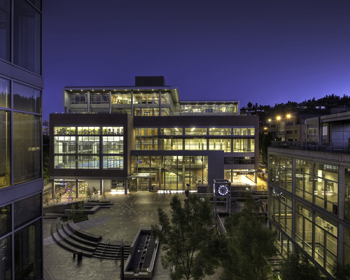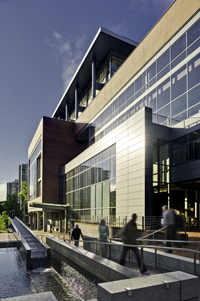Portland State University Delivers on Design
 PORTLAND, Ore. — Yost Grube Hall Architecture (YGH) completed the Academic and Student Recreation Center at Portland State University (PSU) in 2010, but is continuing to receive praise for the stellar design. On Nov. 30, YGH, along with university representatives, accepted the 2012 Athletic Business Facility of Merit award — YGH is one of just 10 firms to receive the honor.
PORTLAND, Ore. — Yost Grube Hall Architecture (YGH) completed the Academic and Student Recreation Center at Portland State University (PSU) in 2010, but is continuing to receive praise for the stellar design. On Nov. 30, YGH, along with university representatives, accepted the 2012 Athletic Business Facility of Merit award — YGH is one of just 10 firms to receive the honor.
The state of Oregon prides itself on sustainable living, and the new center at PSU is a perfect model for the entire state when it comes to energy efficiency and environmentally friendly design. The facility can be used by all students as well as residents throughout the state.
The new LEED Gold certified building features a new gymnasium, pool, jogging track, natatorium and climbing wall. The building also includes academic space for the School of Social Work, offices for the Oregon University System and a new home for the City of Portland Archives.
In order to receive LEED Gold certification the building demonstrated its sustainable features including well water-cooling, UV filtration and a heat recovery system for the pool, maximum solar exposure and an eco-terrace that provides a rainwater harvesting system.
The 208,000-square-foot Academic and Student Recreation Center cost nearly $70 million and was paid for the university, city of Portland and the state of Oregon. Also, in order to fund the building there was a voluntary commitment by PSU students, who contributed to the building through a portion of their student service fees.
The project was completed in a design-build method, with YGH on the design and Skanska USA Building completing construction.
 “The success of the project was achieved through a tight collaborative effort between YGH, Skanska and Portland State University,” said Amy Winterowd, marking director at YGH. “Constant communication and a common understanding of what each party’s goals were was essential to setting the stage for completing a challenging project early and within budget.”
“The success of the project was achieved through a tight collaborative effort between YGH, Skanska and Portland State University,” said Amy Winterowd, marking director at YGH. “Constant communication and a common understanding of what each party’s goals were was essential to setting the stage for completing a challenging project early and within budget.”
Not only is the design and building of the new recreation center impressive at PSU, but the finance method is also equally impressive for the industry and the economic times.
“Public colleges and universities for years now have been strapped for funding and the construction of new publically funded buildings has been few and far between,” said Winterowd. “Yet, in this fiscal environment, PSU has a new $71 million Academic and Student Recreation Center.”
In order to deliver the project, Winterowd explained that PSU “is an excellent example of thinking outside the traditional public financing box.” PSU was able to seek out innovative public and private partnerships to pay for the project. The debt service on $43 million of state authorized bonds will be provided through student recreation funds (providing $35 million) and retail leases on the building’s ground floor (providing another $7 million), according to Winterowd.
The city of Portland also contributed about $10 million to relocate its archives to the new building, providing a more central location for the archives and a resource for faculty and students. The Oregon University System also provided $3 million for the inclusion of space for the chancellor’s office. Through the design-build method, the project also was able to deliver on efficient design and construction that saved on time and added value to the building.
The aesthetically pleasing building is matched with energy-efficient strategies and forward thinking financing decisions, making it a model design for the school, state, and future construction projects.
